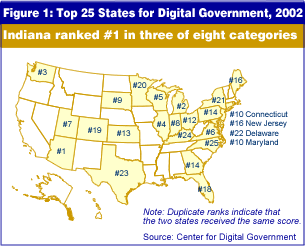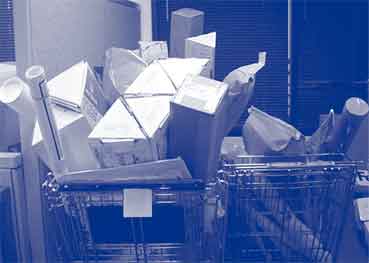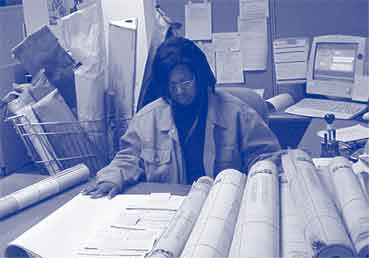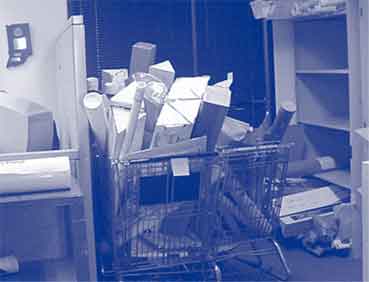Indiana's E-Government: A Story Behind Its Ranking
It may come as a surprise to some Hoosiers that Indiana is a nationally ranked leader in delivering digital services to its citizens. The latest Digital States Survey gave Indiana number one rankings in the areas of taxation and revenue, education, and management and administration, and a number three ranking in e-commerce and business regulation. Overall, Indiana ranked eighth for digital government in 2002 (see Figure 1).

One e-government service offered by Indiana has especially piqued the interest of other states: electronic filing for building permits. For the Indiana State Building Commission, the building-permitting process had slowed to the point that project documents were "filed" in grocery carts awaiting "check-out" for up to three months (see photos). The Associated Builders and Contractors of Indiana trade group deplored the slow response time and consequent project delays-and even cancellations. There were some legislative rumblings that the review process be decentralized, making issuance of appropriate building licenses a local responsibility rather than a state one.

Some blamed the delayed permits on employee churn, while others blamed a significant increase in the number of plans submitted (as a result of strong construction demand). Everyone agreed that the process was flawed.

Commission staff assembled a team to examine the process, adhering to the paired principles of smaller and smarter. Bill Franklin led the team as a state-trained facilitator and observed, "Processes get messy by trying to put Band-Aids on broken or inefficient processes."

Getting Rid of the Grocery Carts
Albert Einstein once said, "No problem can be solved by the same consciousness that created it." With that understanding in mind, Franklin brought together process stakeholders from both inside and outside state government. The effort was all-volunteer and would have floundered without the dedication of individuals from construction and architectural companies. Franklin also attributes some project success to the smaller and smarter structured methodology: minutes of meetings were recorded; assignments and activities were tracked faithfully.
Over a period of 18 months, the team identified extraneous steps in the review process and also realized the sheer burden of paperwork needed to be addressed. An e-filing system seemed logical: reduce the cost of mailing, storing and retrieving paper documents, facilitate plan submissions from around the state and the country and streamline review. Not having the budget for a custom software system, the team identified off-the-shelf and shareware software that would support key system components. Products used included Acrobat Reader, Autoview Professional, Winzip and Microsoft Outlook.
Low or no cost to the Commission was just one advantage to adopting this open software platform approach. It also increased flexibility for those submitting projects for review. The Commission identified vendors that could digitize paper drawings for those architectural and building firms that did not use computer-aided design.
An architect from Washington State saved an estimated $5,000 in time and travel expenses by making submissions electronically. One Hoosier architect said that his firm no longer has to float a loan to construction firms for filing project designs. The construction firm gives the architect its credit card number and the transaction is completed electronically. The same architect said that his firm has also saved reams of paper for each project submitted.
Of course, most dramatically, the e-filing system has cured the project review backlog. The 17-member Commission staff receives about 12,000 filings a year; they must process 40 to 50 per day to stay current. Two-thirds of these filings are new projects, which require multiple filings and multiple reviews.
At present, 25 percent of the filings are electronic, or approximately 60 a week. When first launched, e-filing accounted for about three submissions a week. Electronic submissions can be processed in three to ten days. Electronic seals are affixed to the filings, in accordance with electronic records legislation passed by the Indiana General Assembly.
In addition to the cost saving to architects of not having to float filing fees, other unintended consequences have been realized. Since electronic versions of the building plans are being transmitted to counties for their records, those versions can then be linked to local 911 systems, including GPS. This means, for example, that a fire truck can have a copy of a building's layout loaded into a computer console so that crews know immediately where all stairwells, air ducts and hazardous waste storage can be found.
Improving the Safety Inspection Process
The Building Commission has continued to pursue process improvement for another area of responsibility: safety inspections. The Commission is responsible for inspecting elevators and amusement park rides, in addition to ambulances, pressure vessels (such as hot water tanks) and construction site mobile trailers. Eighteen inspectors examine approximately 15,000 elevators, 1,200 amusement park rides and 60,000 pressure vessels around the state annually.
The process was paper-intensive, redundant and inefficient. Multiple carbon copies of reports had to be filed by building or ride owners, county officials and the Building Commission. Hand-written reports by inspectors were rekeyed by clerical staff for electronic records management. Report documentation did not travel with rides.
Deputy Chief Building Commissioner Bill Franklin had a brainstorm during a presentation on using RFID (Radio Frequency Identification) technology for tracking emergency equipment. He realized that the same information storage concept could be used for amusement rides. Working with private industry firms from New York (SYSGEN) and Indiana (Northern Apex), the Building Commission team developed an approach that is unique in the U.S. Starting in May 2002, inspectors equipped with a portable hand-held computer complete forms electronically and rewrite the data to the RFID tag affixed to the ride. They also use an infrared connection to print the inspection form to a belt-worn mobile printer for the ride owner. New units for inspectors will use Bluetooth technology so printing can be done remotely.
Through a dial-up modem connection, data on the hand-held is uploaded to the Commission's mainframe computer and new pertinent data downloaded to the hand-held. Data integrity is maintained and rekeying tasks are eliminated. As a side benefit, inspectors can access e-mail messages from the field over the hand-held devices.
Other states have expressed interest in the system. The public safety benefits are also clear: inspection reports are now affixed to rides and are readily available, regardless of geographical location or ownership change. The utility of this RFID application for other equipment that requires inspection, such as elevators, is being tested now. The question is whether or not chip readers will be made available for those of us riding elevators who can't help wondering what those inspection reports filed in the building maintenance office really say. . .
Jennifer Kurtz
eCommerce Director, Indiana Department of Commerce
